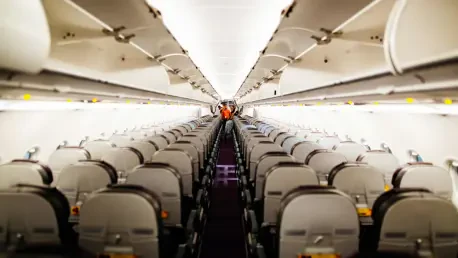Picture a critically ill patient being airlifted to a life-saving treatment center, their condition teetering on the edge as the aircraft navigates through turbulent skies, with every moment crucial to their survival. Inside the confined space of the cabin, medical equipment such as ventilators, monitors, and defibrillators—each weighing between 10 and 19 pounds—stands as the lifeline for survival. Yet, if this heavy gear isn’t securely fastened, a sudden jolt or emergency landing could transform these vital tools into dangerous projectiles, endangering patients, medical staff, and the integrity of the equipment itself. The stakes in air medical transport are extraordinarily high, where every detail matters in ensuring safety and effective care. This pressing reality drives the need for innovative solutions tailored to the unique challenges of such environments.
The complexity of air medical transport lies not only in the urgency of the patients’ conditions—ranging from trauma victims to fragile newborns—but also in the logistical puzzle of managing essential gear in tight quarters. Unsecured equipment poses a tangible threat, capable of causing severe injury or damage during unexpected turbulence. Fortunately, advancements in mounting systems are addressing these risks head-on, offering robust solutions that prioritize both safety and efficiency. Companies like Technimount EMS are at the forefront of this progress, developing products that meet stringent safety standards while enhancing accessibility for medical teams. This exploration delves into the specific challenges of air transport, the groundbreaking innovations mitigating these issues, and the broader impact on patient and provider safety in one of healthcare’s most demanding arenas.
Navigating the Unique Challenges of Air Medical Transport
Space and Accessibility Constraints
The interior of an aircraft used for medical transport is a stark contrast to the spacious environment of a hospital room, presenting a logistical challenge that demands precision and ingenuity. With every inch of space at a premium, medical teams must organize an array of life-saving equipment—ventilators, monitors, and infusion pumps—within arm’s reach while ensuring nothing obstructs critical movements during emergencies. Mounting systems play a pivotal role in this delicate balance, designed to secure gear firmly without sacrificing accessibility. These systems must allow for rapid adjustments and quick access, as delays of even a few seconds can impact patient outcomes in high-stakes situations. The confined quarters amplify the need for solutions that not only fit within limited dimensions but also maintain an uncluttered workspace, enabling providers to focus on care rather than navigating a maze of unsecured tools.
Beyond the spatial constraints, the dynamic nature of air transport adds another layer of complexity to equipment management, making it a challenging aspect of medical aviation. Unlike ground ambulances, aircraft are subject to frequent shifts in altitude and sudden turbulence, which can dislodge improperly secured devices if mounting systems are not up to the task. The challenge is compounded by the diverse needs of patients, from adults requiring multiple monitoring devices to neonates in specialized incubators, each demanding tailored setups. Effective mounting solutions must therefore be versatile, accommodating a range of equipment configurations while ensuring that medical staff can perform interventions without hindrance. This dual focus on space optimization and operational fluidity underscores the critical importance of innovative designs in maintaining safety and efficiency during flights.
Risks of Unsecured Equipment
The potential hazards posed by unsecured medical equipment in air transport cannot be overstated, as the consequences of failure are both immediate and severe, threatening the safety of everyone on board. Devices such as ventilators, often weighing between 10 and 18 pounds, and monitor-defibrillators, ranging from 12 to 19 pounds, can become lethal projectiles during turbulence or an emergency landing if not properly anchored. Such incidents risk serious injury to patients already in critical condition, as well as to the medical personnel striving to provide care in an already stressful environment. Moreover, damage to expensive equipment can render it inoperable at a crucial moment, further jeopardizing patient survival. The gravity of these risks highlights the urgent need for robust mounting systems that can withstand the unpredictable forces encountered in flight.
Addressing these dangers requires more than just basic restraints; it demands solutions engineered to endure extreme conditions while maintaining reliability. The history of air medical transport includes accounts of equipment dislodging mid-flight, leading to compromised missions and heightened safety concerns. Federal regulations have since tightened to mitigate such risks, but compliance alone isn’t enough—systems must be intuitive and adaptable to real-world scenarios. The emphasis on secure mounting extends beyond protecting individuals to preserving the functionality of life-saving tools, ensuring they remain operational when every second counts. This pressing need for dependable security measures drives ongoing innovation in the field, pushing manufacturers to develop systems that eliminate the vulnerabilities of unsecured gear in high-risk transport settings.
Cutting-Edge Solutions for Equipment Security
Xtension Pro Assistant – LP for Adult Care
Among the pioneering solutions transforming air medical transport, the Xtension Pro Assistant – LP stands out for its targeted design catering to adult patients with complex needs. Engineered for compatibility with the LifePort cot, this mounting system secures multiple critical devices, such as ventilators and monitors, using adjustable bases and shelves that adapt to varying equipment sizes. Its quick-release mechanism allows medical teams to attach or detach the system in mere seconds, a feature that proves invaluable during time-sensitive emergencies. This adaptability ensures that care for critically ill adults, often requiring extensive monitoring and interventions, isn’t disrupted by cluttered or unsafe setups. By organizing equipment efficiently within the tight confines of an aircraft, the system minimizes hazards and maximizes the focus on patient treatment.
Equally significant is the emphasis on durability and compliance with safety standards that the Xtension Pro Assistant – LP embodies. Meeting rigorous federal regulations, including FAA/CFR § 23.561 for emergency landings, it guarantees that secured devices remain in place even under extreme conditions like sudden descents or severe turbulence. This reliability offers peace of mind to medical staff, who can trust that their tools won’t become liabilities mid-flight. Furthermore, the design incorporates feedback from frontline providers, ensuring that the system aligns with real-world demands, such as ease of use for staff with varying levels of experience. The result is a mounting solution that not only enhances safety but also streamlines the delivery of advanced care to adult patients in the challenging environment of air transport.
Neonatal Transport Incubator Platform – FL for Newborns
For the most vulnerable patients—newborns requiring intensive care during air transport—the Neonatal Transport Incubator Platform – FL offers a specialized solution that addresses unique challenges. Designed to integrate seamlessly with incubators like Dräger’s Isolette TI500 on LifePort’s AeroSled TS, this platform enables standard stretchers to support neonatal intensive care without the need for dedicated equipment. Its compact and adaptable structure allows for the secure mounting of advanced life-support systems alongside incubators, ensuring that fragile infants with conditions like respiratory distress or congenital defects receive uninterrupted care. The use of quick-release latches further enhances operational efficiency, allowing medical teams to configure setups swiftly while maintaining a clutter-free workspace in the aircraft.
Safety and flexibility are at the core of this platform’s design, reflecting a deep understanding of neonatal transport’s distinct requirements, while ensuring that every detail is crafted to meet the unique challenges of such critical missions. Compliance with stringent standards, such as SAE J3043 for equipment mounting, ensures that all components remain secure during the unpredictable conditions of flight, protecting both the infant and the surrounding medical staff. Additionally, the system avoids rigid configurations that could limit clinical flexibility, empowering providers to adapt to evolving patient needs mid-transport. By incorporating user feedback, the platform has been refined to prioritize intuitive operation, reducing the learning curve for part-time or less experienced personnel. This focus on tailored innovation underscores the critical role of specialized mounting systems in safeguarding the tiniest patients during high-stakes air medical missions.
Ensuring Safety Through Standards and Compliance
Meeting Federal Regulations
In the high-risk domain of air medical transport, adherence to federal safety standards is not just a benchmark but a fundamental requirement for protecting lives and equipment. Mounting systems like the Xtension Pro Assistant – LP and the Neonatal Transport Incubator Platform – FL are meticulously engineered to comply with regulations such as FAA/CFR § 23.561, which governs emergency landing conditions, as well as CFR § 23 and § 25 for airworthiness. These standards ensure that equipment remains firmly in place even during severe turbulence or sudden impacts, mitigating the risk of injury or damage. Compliance with SAE J3043, specific to ambulance equipment mounting, further reinforces the reliability of these systems under extreme stress. Such rigorous testing and certification provide a critical safety net in an environment where there is no margin for error.
The importance of meeting these regulations extends beyond technical specifications to the broader implications for trust and operational integrity in air medical services. When mounting systems pass these stringent evaluations, they assure medical teams and transport operators that their tools will perform as expected, regardless of flight conditions. This assurance is vital for maintaining focus on patient care rather than worrying about equipment stability. Additionally, adherence to federal guidelines helps standardize safety practices across different air transport providers, fostering a unified approach to risk management. The commitment to these standards reflects an industry-wide recognition that robust compliance is the foundation of secure and effective medical transport in the skies.
Protecting Patients and Providers
The ultimate goal of safety compliance in mounting systems transcends merely checking regulatory boxes—it directly impacts the well-being of patients and medical providers during critical missions. By ensuring that heavy equipment like ventilators and defibrillators remains anchored under the harshest conditions, these systems prevent potential injuries that could occur if gear were to dislodge mid-flight. For patients already in fragile states, such as trauma victims or newborns with life-threatening conditions, this protection is paramount, as any additional harm could be catastrophic. Equally, safeguarding medical staff from flying objects allows them to perform their duties without the added risk of personal injury, preserving their ability to deliver life-saving interventions in a high-pressure setting.
Moreover, the protective role of compliant mounting systems extends to the preservation of expensive medical devices, which are often indispensable during transport. Damage to such equipment not only incurs significant replacement costs but also risks rendering it unusable at a crucial moment, potentially compromising patient outcomes. The design of these systems, aligned with airworthiness and emergency landing regulations, minimizes such vulnerabilities, ensuring that both human lives and critical tools are shielded from harm. This dual focus on protection underscores the broader mission of air medical transport: to create a secure environment where the focus remains on healing, even amidst the unpredictable challenges of flight. The integration of safety-driven engineering in mounting solutions thus serves as a cornerstone for trust and reliability in this vital field.
Enhancing Efficiency with User-Centric Design
Incorporating Feedback from Medical Teams
A distinguishing feature of modern mounting systems for air medical transport lies in their development process, which heavily relies on direct input from the medical professionals who use them daily. Companies like Technimount EMS prioritize collaboration with end users, gathering insights from paramedics, nurses, and transport specialists to shape products that address real-world challenges. This user-centric approach ensures that systems like the Xtension Pro Assistant – LP and Neonatal Transport Incubator Platform – FL are not only safe but also practical and intuitive. Features such as adjustable configurations and straightforward locking mechanisms stem from feedback highlighting the need for versatility and ease, particularly for staff who may not handle complex setups regularly. This alignment with frontline needs enhances the overall effectiveness of care delivery in constrained aircraft environments.
The impact of incorporating such feedback is evident in the seamless integration of these systems into high-stress workflows, where medical teams often operate under intense time constraints. Cumbersome equipment mounts can hinder critical interventions in these environments. By refining designs based on user experiences, manufacturers eliminate unnecessary complications, ensuring that even part-time or less experienced personnel can operate the systems with confidence. This collaborative design philosophy also fosters a sense of ownership among providers, as their input directly influences tools that support their mission to save lives. The result is a mounting solution that resonates with the practical demands of air transport, reinforcing safety and efficiency through a deep understanding of the end user’s perspective.
Streamlining Operations in Emergencies
In the fast-paced realm of air medical transport, efficiency can mean the difference between life and death, and mounting systems are pivotal in shaving off precious seconds during emergencies. Innovations like the quick-release mechanisms in the Xtension Pro Assistant – LP allow medical teams to secure or reposition equipment in moments, ensuring that setup time doesn’t delay critical care. Similarly, the Neonatal Transport Incubator Platform – FL employs patented XClamp technology to facilitate rapid conversions of standard stretchers for neonatal use, eliminating the need for dedicated units and simplifying logistics. These time-saving features are crucial in scenarios where every tick of the clock matters, enabling providers to maintain focus on patient stabilization rather than wrestling with unwieldy equipment mounts.
Beyond speed, the streamlined operation of these systems reduces mental and physical strain on medical staff, who often work in high-pressure conditions with little room for error. The intuitive designs minimize the learning curve, ensuring that even those new to the equipment can use it effectively during a crisis. This operational simplicity also translates to fewer mistakes, as clear mechanisms reduce the likelihood of improper securing or delays due to confusion. By prioritizing ease of use alongside robust safety features, these mounting solutions empower teams to act decisively, enhancing patient outcomes in the chaotic environment of air transport. The emphasis on efficiency through smart engineering reflects a broader commitment to supporting medical providers with tools that match the urgency of their life-saving work.
Reflecting on Transformative Impact
Looking back, the journey of mounting systems in air medical transport revealed a landscape once fraught with risks from unsecured equipment, where the potential for injury or equipment failure loomed large over every mission. The introduction of tailored solutions like the Xtension Pro Assistant – LP and Neonatal Transport Incubator Platform – FL marked a turning point, addressing the perils of confined spaces and unpredictable flight conditions with precision-engineered designs. These systems not only met stringent federal safety standards but also incorporated user feedback to ensure practicality, transforming the way critical gear was managed during high-stakes transports. Their adaptability to diverse patient needs, from adults to newborns, underscored a holistic approach to safety that left no one unprotected.
Moving forward, the focus should shift to expanding access to such innovative mounting systems across all air medical services, ensuring that even smaller operators can benefit from enhanced safety and efficiency. Investment in ongoing training for medical teams will further solidify the effective use of these tools, embedding their intuitive features into standard protocols. Additionally, continued collaboration between manufacturers and providers can drive future refinements, addressing emerging challenges as patient care technologies evolve. The legacy of these advancements lies in their ability to inspire a safer, more reliable framework for air transport, paving the way for broader industry standards that prioritize life above all else in the skies.









